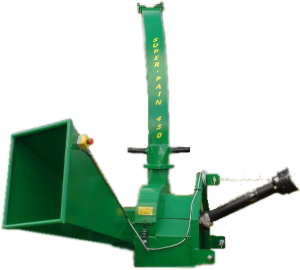Two possibilities for heating with dry chipped wood.
The calorific value of wood is directly related to its relative humidity.
In theory, automatic chip boilers are able to burn wet chips. The adjustment of the combustion on the boiler must be made accordingly.
The wetter the chips are, the higher the power needed will be. Part of the energy released by burning wood will be used to dry the chips, and will end up as vapor in the smoke. It is conceivable to condense the flue gases, which would recover the lost energy.
But if you want the best overall performance, it is necessary to use dry chips.
There are two ways to obtain this result.
1 ) Prepare the wood in logs and let it dry before chipping.
This method needs less space to stock needed volume of wood. (it can be stocked as logs since we need it as chips)
As the chipping is made close to the boiler's silo, the chipper is used to fill it directly.
But it has several disadvantages.
- The necessity of multiple handling during production, since the chipping is not made at the time of cutting the wood. It is not possible to use small branches.
- The chippers works harder if they have to chip dry wood than when they chip fresh one.
- It is not possible to dry the wood under 20% humidity, and moisture come-back may occurs in some cases.
- During chipping, more dust is produced.
2 ) Chipping on cutting site and drying of the chipped material by fermentation.
This method has several advantages.
- It reduces handling of the wood and allows to use every parts of the tree, even small branches.
- If the chipper's input is large enough, it is possible to put in small trees without re-cutting them.
- When the cut is done, the site is "clean".
- Chippers works easier and have more output.
- The fermentation rises temperature of thc chips heap and it becomes possible to dry the chips under 20% humidity (we recorded 15% humidity in a heap of one of our customers).
- During chipping, fresh wood produces less dust than dry wood.
The major drawback is that in many cases, it is necessary to provide an intermediate storage, and a device adapted for loading the silo of the boiler.
We believe if cutting constraints, particularly in regard to relief, do not interfere with the chipping on cutting site, it seems clear that the second method is preferable. This method is detailed in a dedicated page.


